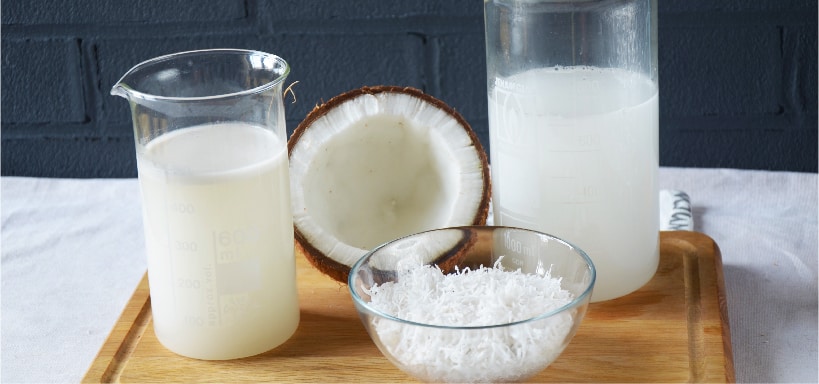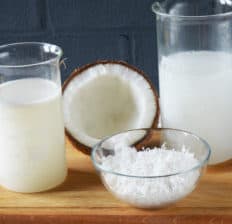How to Make Coconut Milk

Many people feel that canned or boxed coconut milk can’t compare to the homemade kind. They’re right! Luckily, you can easily make your own full-fat coconut milk at home by purchasing fresh, young coconuts. This also ensures your coconut milk is free from any artificial ingredients or preservatives.
Is raw coconut good for you? You bet. In addition to providing nutrients and its awesome taste, coconut milk nutrition contains beneficial fat called lauric acid. Lauric acid is a medium-chain fatty acid that’s easily absorbed and used by the body for energy.
Coconuts’ fatty acids are primarily saturated fats, but don’t think these raise your cholesterol levels and cause heart damage. Instead, they’re known to actually do the opposite. Coconut milk nutrition can help you lower cholesterol levels, improve blood pressure, and even prevent heart attacks or a stroke.
Look for fresh, mature coconuts in the refrigerated section of health food stores, or try using coconut meat that’s been removed from the shell already.
Just make sure to find coconuts or coconut meat that are still fresh. Also ensure it is either vacuum-sealed or opened within the past three to five days. The fresher the coconut is, the longer the coconut milk lasts.
How to Make Coconut Milk
First look for fresh coconuts and give them a good shake, making sure you can hear and feel some liquid moving around inside. That tells you they’re fresh.
You need a sturdy cleaver to crack open a coconut, but you can also use any heavy knife or a hammer you may have at home.
Bang the cleaver on the top of the coconut until you hear a crack. Then strain the coconut water out, and keep it for smoothies and other refreshing drinks. You’re left with two–three coconut pieces that have the white flesh/meat inside attached to the inedible shell. Remove the flesh either by cutting it out with a paring knife or continue to hit the back of the coconut until the meat falls off from the shell.
Rinse the coconut meat well, and chop it into small pieces. Then add your coconut meat to a blender or food processor along with about two cups of water.
Blend it into a thick liquid, and then strain it using a metal strainer or cheesecloth so you can separate the coconut pulp/meat from the coconut milk. Squeeze the coconut pulp well with your hands to get the most coconut milk to strain out.
That’s it! Keep in mind that after you make coconut milk, you can keep the leftover coconut meat to make homemade coconut flour, coconut scrubs, to make dried coconut flakes or to add to smoothies.
Print
Coconut Milk Recipe
- Total Time: 15 min
- Yield: 3 1x
- Diet: Vegan
Description
You can make your own full-fat coconut milk at home by purchasing fresh, young coconuts. This also ensures your coconut milk is free from any artificial ingredients or preservatives.
Ingredients
- one fresh coconut (Make sure you can hear and feel some liquid moving around inside)
Instructions
- With a sturdy cleaver, crack open the coconut. Bang the cleaver on the top of the coconut until you hear a crack. Be very careful by removing your other hand when using cleaver. Do NOT hold the coconut when using the cleaver unless you’re an expert.
- Strain the coconut water out, and keep it for smoothies and other refreshing drinks.
- With the coconut pieces left, scoop our the white flesh/meat inside. Use a paring knife or continue to hit the back of the coconut until the meat falls off from the shell.
- Rinse the coconut meat well, and chop it into small pieces. Then add your coconut meat to a blender or food processor along with about two cups of water.
- Blend it into a thick liquid, and then strain it using a metal strainer or cheesecloth so you can separate the coconut pulp/meat from the coconut milk.
- Squeeze the coconut pulp well with your hands to get the most coconut milk to strain out.
Notes
After you make coconut milk, you can keep the leftover coconut meat to make homemade coconut flour, dried coconut flakes or add to smoothies.
- Category: Beverages
Nutrition
- Serving Size: 8 ounces
- Calories: 552
- Sugar: 8g
- Sodium: 36mg
- Fat: 57.2g
- Saturated Fat: 50.7g
- Unsaturated Fat: 3g
- Trans Fat: 0g
- Carbohydrates: 13.3g
- Fiber: 5.3g
- Protein: 5.5g
- Cholesterol: 0mg
Comments
Please keep comments under 200 characters.




Playing poppy playtime is something I encourage. This is an excellent game for de-stressing and relaxing.